Potato variety “Khozyayushka” for growing in the northern regions
The Hostess variety is popular among gardeners due to its ability to grow in almost any climate and to withstand temperature changes, droughts and frosts. Both amateur summer residents and professional farmers will appreciate the high yield and unpretentiousness of this variety.
All the details about the Khozyayushka variety and the rules for its cultivation are in our article.
Description of the variety
Potato The hostess easily tolerates temperature changes - It grows in both hot and cold climates. It has an excellent taste that is preserved even after long-term storage. It tolerates transportation well over long distances. The hostess can be found not only on market stalls, but also in hypermarkets.
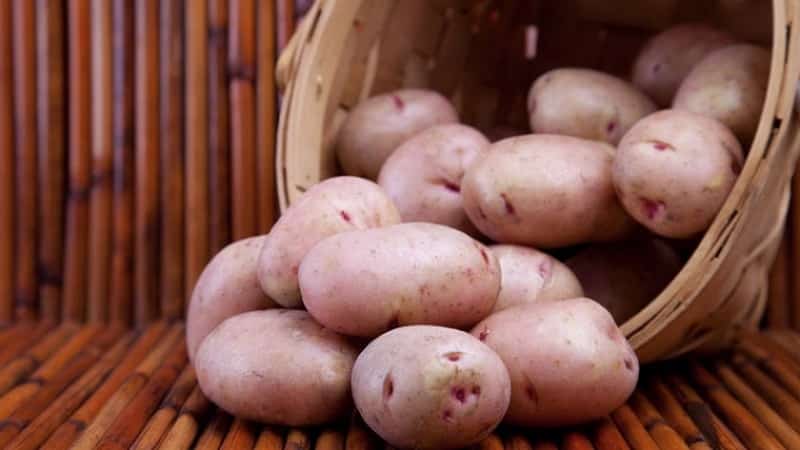
During heat treatment, the pulp retains its color. This is a versatile table potato variety - it can be fried, boiled and steamed. It is used in the production of chips, French fries, starch and instant mashed potatoes.
Origin and development
Potato The hostess was bred by breeders of the Siberian Research Institute of Chemical Chemistry, this is the result of crossing the Zarevo and Sante varieties. After testing was completed in 2009, it was entered into the Russian state register.
Chemical composition, trace elements and vitamins
Tubers contain potassium, calcium, carotene, phosphorus, vitamins A, B, C. Starch content in this variety exceeds 20%, which is considered a high figure.These potatoes boil well and are suitable for mashed potatoes.
Attention! Green tubers contain the plant poison solanine. It accumulates in potatoes when exposed to sunlight. It is also found in higher concentrations in aboveground berries (fruits) of potatoes.
Ripening period
Harvest ripening time - 80-90 days, in regions with cold climates - 100 days. In the central regions, harvesting begins in September.
Productivity
Variety has high productivity. Under favorable conditions, each bush produces an average of 12-18 tubers. You can get up to 500-600 centners of potatoes per hectare.
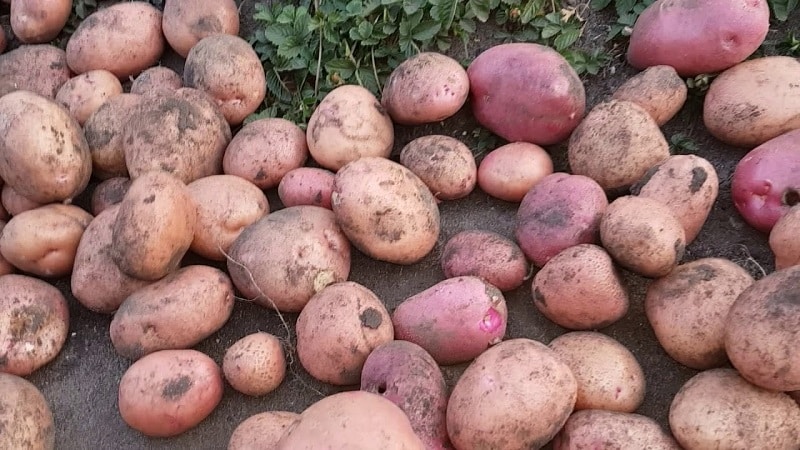
Disease resistance
Is resistant to diseases: potato cancer, golden and cyst nematodes. Moderately resistant to late blight and rhizoctonia.
Characteristics of tubers, description of appearance
Potatoes have an average weight of 100-150 g, but specimens up to 200 g can be found. The tubers are pink or purple, have an oval-round shape, they have a thin and smooth skin, and cream-colored flesh.
Which regions are best suited and climate requirements?
This potato variety is well suited for growing in the southern and central regions of Russia, as well as in southern Siberia. The originator recommends the Hostess for cultivation in the Omsk, Tyumen, Tomsk, Kemerovo, Novosibirsk and Irkutsk regions. However, the variety is successfully grown not only in Russia, but also in Belarus, Ukraine and Moldova.
Important! In cold regions of the country it is rarely possible to plant potatoes on time. But being late for boarding is unacceptable. If planting is delayed for more than 15 days, yields can be reduced by 50%.
The main advantages and disadvantages of the variety
Main advantages of the variety:
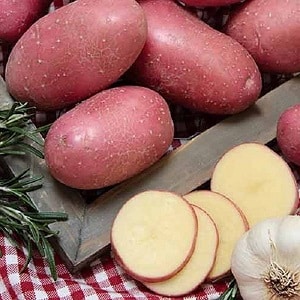 one of the few varieties that can tolerate both drought and cold weather;
one of the few varieties that can tolerate both drought and cold weather;- retains taste during long-term storage;
- has high productivity;
- under favorable conditions it can be stored for up to 8-9 months;
- withstands difficult conditions of long-distance transportation;
- not prone to darkening after cutting;
- excellent marketability of root crops (85-98%)
The disadvantages are:
- prone to late blight and other fungal diseases;
- when growing in unfavorable conditions, it is prone to cracking and the appearance of a large number of small tubers.
What is the difference from other varieties
The variety is unpretentious to the weather and does not require special care., thanks to which it is guaranteed to produce a good harvest. One of the most unassuming potato varieties. Contains an increased amount of starch.
Features of planting and growing
Planting and growing This potato has its own characteristics.
Preparing for landing
It is recommended to plant sprouted potatoes. This is most relevant in the middle zone and Siberia, where summer is short. Thanks to germination, seedlings will appear faster, and the crop will have time to ripen before the onset of frost.
For germination, potatoes are laid out in a warm and bright place. 2-3 weeks before the planned planting date. Before planting, tubers are disinfected in a pink solution of potassium permanganate or sprayed with copper sulfate. You can also treat the seed material with growth stimulants, for example, Epin, Regoplant, Kornevin, Bioglobin or Poteytin.
These the preparations are also suitable for spraying plants before flowering, to increase yield and additionally protect against late blight, Colorado potato beetle and other pests.
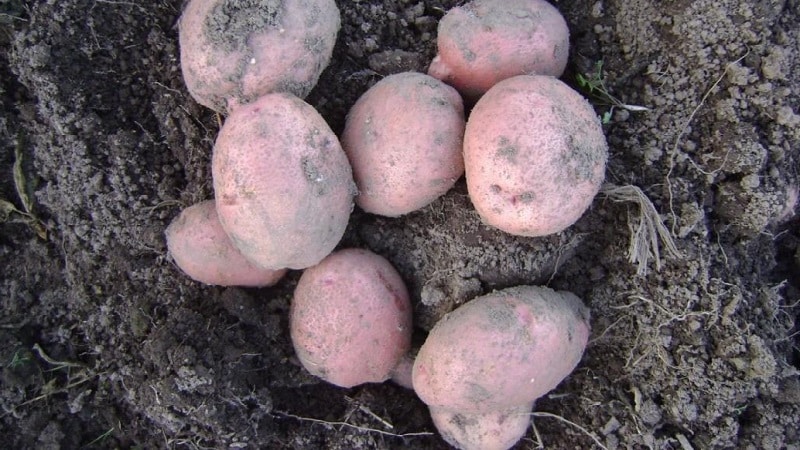
Soil requirements
The hostess grows actively in sandy and loamy soils with the addition of chernozem. The highest yield is shown in sandy soil. It grows extremely poorly in petrified soil.
Dates, scheme and rules of planting
Potatoes are planted in May, after frost has passed. and the earth will warm up to 7-8°C at a depth of 8-10 cm.
The holes are dug to a depth of 7-10 cm, in clay soils - no deeper than 3 cm. Before planting, a tablespoon of ash is poured into them, sprinkled with 2 cm of soil on top and then the tubers are placed.
The tubers are placed in the soil at a distance of at least 35 cm from each other, 50-60 cm are left between the rows. This scheme will provide space for the plant to grow, and it will also be more convenient to weed and hill up.
Features of cultivation and nuances
Traditional methods are used for planting and growing.: hilling, mulching, watering, fertilizing. Hostess is an unpretentious variety, and there are no special requirements for its cultivation.
Watering mode
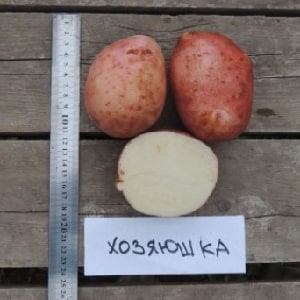 Watering is required periodically, but like other potato varieties, Hostess does not like excess moisture. Water with warm, settled water in the morning or evening. and so that water does not get on the tops. The soil should be moist to a depth of 50 cm, which will provide moisture to the roots of the plant.
Watering is required periodically, but like other potato varieties, Hostess does not like excess moisture. Water with warm, settled water in the morning or evening. and so that water does not get on the tops. The soil should be moist to a depth of 50 cm, which will provide moisture to the roots of the plant.
Water for the first time when the tops reach a height of 10 cm, pouring 3 liters under the bush. The next time - after the start of flowering, 6-7 liters per bush, the third time - when the flowers disappear, up to 12 liters per bush. Three waterings will be enough, but if the weather is hot, you can add 2-3 more times.
After flowering, watering is undesirable, as the risk of late blight increases.
Top dressing
Before you start hilling, it is recommended to feed the plants. For the first feeding, use a solution in which a couple of ash or chicken droppings are added to 5 liters of water. Next time, pour a solution under the root of the plant, adding 2 tbsp per 5 liters. l. superphosphate and 1 tbsp. l. nitrophoska. To apply fertilizer, use a watering can and water under the bush.
Attention! Regardless of the composition, the plants are watered abundantly before fertilizing. Otherwise, nutrients will be poorly absorbed. And applied in liquid form can damage the roots of the plant.
To prevent nitrates from accumulating in tubers, fertilizing should not be done after the plant has flowered.
Weeding and hilling
Weeding is carried out when the plant height reaches 13-18 cm, after 2 weeks weeding is repeated. When the tops get stronger, there will be no need for weeding, since the plants cope with weeds on their own.
Hilling is recommended to be done twice:
- When the plant reaches a height of 20-25 cm.
- Three weeks after the first hilling.
Hilling and loosening are carried out after watering or rain.
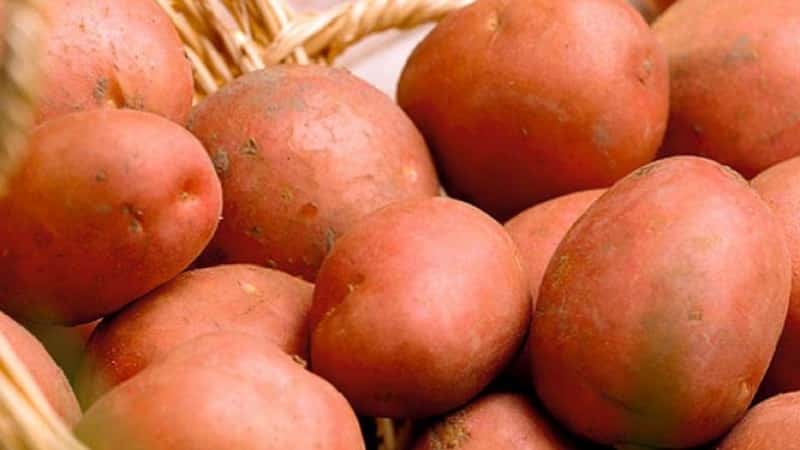
Disease and pest control
The hostess is susceptible to such diseases: common scab, black scab (rhizoctoniosis) and late blight.
To combat them, fungicides containing copper are used: copper sulfate, copper sulfate, Bordeaux mixture, manganese sulfate. Scab spores can survive in the soil for up to three years. Therefore, it is recommended to change planting sites regularly. In the fall, after digging up potatoes, the tops are burned to reduce the risk of disease.
Common scab. Potato varieties with a thin shell are susceptible to it. The disease rarely affects tops and roots. Externally, this fungus looks like small dried sores. Often the fungus appears on small tubers, barely 3 cm.The affected root crop has an unattractive appearance and its taste deteriorates.
Black scab. This fungus infects the plant completely. Often leads to the death of the bush. The tubers are covered with small black spots, which increase with the growth of the plant. This fungus loves high humidity and temperature.
Late blight - the most dangerous potato disease. The main predisposing factor is high humidity. For prevention purposes, the beds are treated with fungicides.
The most dangerous pest of the variety is Colorado beetle. Insecticides are used to combat it. Spraying of bushes is carried out several times a season. But they resort to chemistry in the most extreme cases. It is better to start with protective measures: using healthy planting material and soil, manually collecting larvae and adults, spraying plants with decoctions of celandine, tansy, basil and other plants.
Attention! Three weeks before harvesting potatoes, stop treating plants with any chemicals.
Harvest and storage
Collection and storage of Hostesses have their own characteristics.
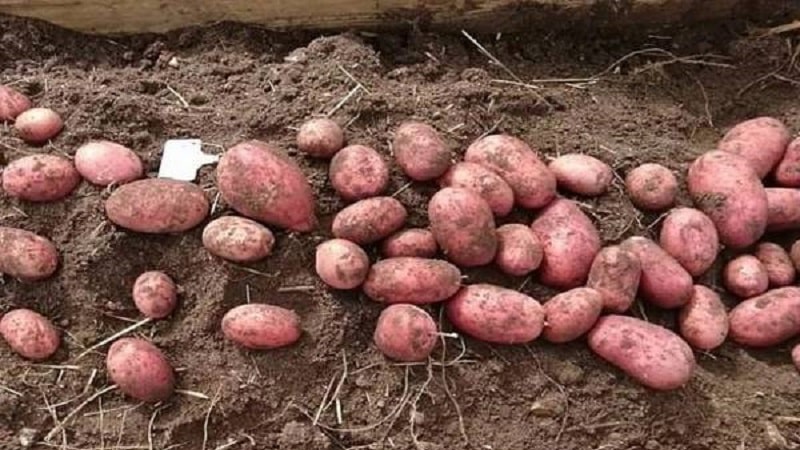
How and when to collect
Hostess belongs to the mid-late varieties. Harvest is harvested in September. About a week before digging, the tops are mowed, which stimulates the flow of nutrients to the tubers. Harvesting is carried out in dry sunny weather; after harvesting, the tubers are ventilated for several hours outside, but not in direct sunlight. Store potatoes in a cool, dry place.
Specimens selected for planting are left outdoors longer, stimulating the synthesis of solanine. Greened potatoes will be protected from diseases and pests, their germination and productivity will increase.
Attention! Green potatoes should not be eaten!
Storage features and keeping quality of the variety
The variety has excellent keeping quality - more than 90%. Tubers do not have a tendency to germinate. Under favorable conditions it can be stored for six months or longer.
What difficulties may there be when growing
Of great importance inspection of tubers when selecting for planting material. Tubers must be free of visible damage and signs of damage. It is not recommended to cut them when planting. Low quality planting material significantly reduces productivity.
The best tubers for planting are grown from seeds. They have increased resistance to diseases and pests.
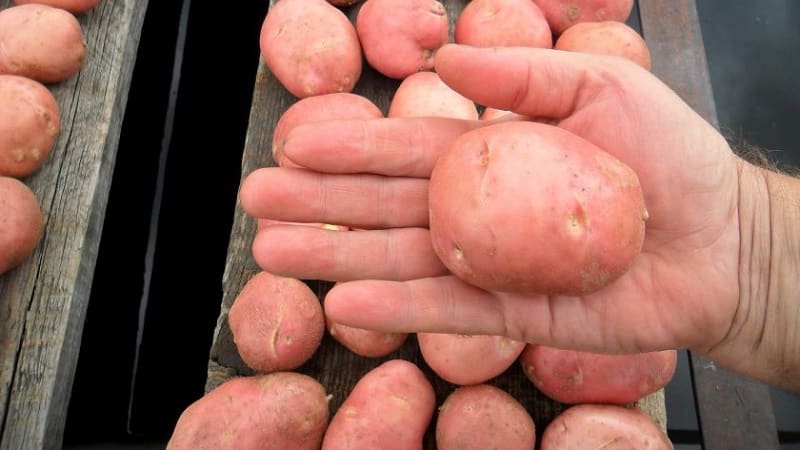
Advice from experienced gardeners and reviews about the Hostess variety
Summer residents love this variety and share their tips and impressions with readers.
Yulia, Moscow region: “A neighbor shared planting material with us - it was the Hostess. Now she pleases us with a stable harvest every year. My husband and I have been growing it on our plot for more than five years. The taste is excellent. I don’t recommend it for frying, as it crumbles.”
Elena, Sverdlovsk region: “Two years ago we tried to plant Hostess and we liked this variety. We were pleased with its yield - a large number of tubers from one bush, thanks to which even in a small area you can get a good harvest. We like to make mashed potatoes from these potatoes; they’re also good for soup, but they’re not very suitable for frying—they start to crumble.”
Nikolay, Chelyabinsk region: “We tried many varieties at our summer cottage, but settled on the Khozyushka variety. Since this variety of potatoes does not require special care and gives good results regardless of the weather.I also liked the small number of spoiled tubers during winter storage. I recommend planting Hostess in a well-lit area and after perennial herbs.”
Conclusion
The popularity of the Khozyayushka potato variety is explained by its resistance to the vagaries of nature, high yields with minimal care, good keeping quality and excellent taste.